Can You to Flush Food in the Toilet?
Can You to Flush Food in the Toilet?
Blog Article
Any individual seems to have his or her own piece of advice in relation to Is it safe to flush food (especially rice) down the toilet?.

Intro
Many people are commonly faced with the predicament of what to do with food waste, especially when it comes to leftovers or scraps. One usual inquiry that arises is whether it's okay to purge food down the bathroom. In this post, we'll look into the reasons why people may think about purging food, the consequences of doing so, and alternative techniques for proper disposal.
Reasons individuals could consider flushing food
Lack of awareness
Some individuals may not recognize the potential damage caused by flushing food down the toilet. They may erroneously think that it's a safe technique.
Convenience
Purging food down the commode might feel like a fast and simple option to getting rid of unwanted scraps, specifically when there's no neighboring garbage can offered.
Idleness
In many cases, people might simply pick to flush food out of sheer negligence, without thinking about the consequences of their activities.
Repercussions of flushing food down the commode
Ecological influence
Food waste that ends up in waterways can add to pollution and damage water environments. Additionally, the water utilized to flush food can strain water resources.
Pipes issues
Purging food can result in stopped up pipes and drains pipes, triggering expensive plumbing repair work and troubles.
Kinds of food that ought to not be purged
Fibrous foods
Foods with coarse structures such as celery or corn husks can obtain tangled in pipelines and trigger clogs.
Starchy foods
Starchy foods like pasta and rice can soak up water and swell, causing blockages in pipelines.
Oils and fats
Greasy foods like bacon or food preparation oils ought to never ever be purged down the toilet as they can solidify and trigger blockages.
Proper disposal methods for food waste
Utilizing a waste disposal unit
For homes furnished with waste disposal unit, food scraps can be ground up and flushed with the plumbing system. However, not all foods are suitable for disposal in this way.
Recycling
Particular food packaging materials can be recycled, decreasing waste and decreasing ecological influence.
Composting
Composting is an environmentally friendly method to throw away food waste. Organic products can be composted and made use of to improve soil for gardening.
The relevance of appropriate waste monitoring
Reducing environmental harm
Appropriate waste monitoring practices, such as composting and recycling, aid decrease contamination and protect natural deposits for future generations.
Shielding plumbing systems
By preventing the method of flushing food down the toilet, property owners can stop pricey pipes fixings and preserve the stability of their plumbing systems.
Final thought
Finally, while it may be tempting to purge food down the commode for comfort, it is necessary to comprehend the potential repercussions of this activity. By embracing appropriate waste monitoring techniques and disposing of food waste properly, people can contribute to much healthier pipes systems and a cleaner atmosphere for all.
FLUSH FOOD DOWN THE TOILET?
FLUSHING FOOD CAN CAUSE BLOCKED DRAINS IN YOUR HOME
All of the plumbing fixtures in your home are connected to the same sewer pipe outside of your home. This outdoor sewer pipe is responsible for transporting all the wastewater from your home to the Council sewer mains. Even small pieces of food that go down the kitchen sink can cause problems for your sewer. It should therefore be obvious that flushing larger bits of food, such as meat, risks a clog in either the toilet itself or the sewer pipes. Flushing greasy food is even more problematic because oil coagulates when it cools, coating the interior lining of your pipes.
THE TOILET IS NOT A BIN
Food isn’t the only thing that people shouldn’t be flushing down the toilet. People use the toilet to dispose of all kinds of things such as tampons, makeup wipes, dental floss, kitty litter and even underwear. Water goes to great lengths to educate residents about the high costs and stress placed on wastewater treatment systems simply from people flushing the wrong stuff down the toilet. It costs taxpayers millions of dollars each year, and homeowners thousands in blocked drain repairs.
FLUSHING FOOD IS A WASTE OF WATER
Flushing food is a waste of our most precious resource - water. In June this year Level 1 water restrictions were introduced to protect water supply from drought conditions. Much of New South Wales continues to be affected by prolonged drought with recent figures revealing up to 97 per cent of the state remains in drought. Depending on whether you have a single or dual flush toilet, every single flush uses between five and 11 litres of water. In the current climate this is a huge amount of water to be wasting on flushing food that should be placed in the bin (or better yet, the compost).
https://www.jabplumbingsolutions.com.au/blog/can-you-flush-food-down-the-toilet

I hope you enjoyed our topic about Think Twice Before Flushing Food Down Your Toilet. Thanks a ton for taking the time to read through our blog. Do you know about anybody else who is fascinated by the niche? Why not promote it. Many thanks for being here. Come back soon.
Call Today Report this page